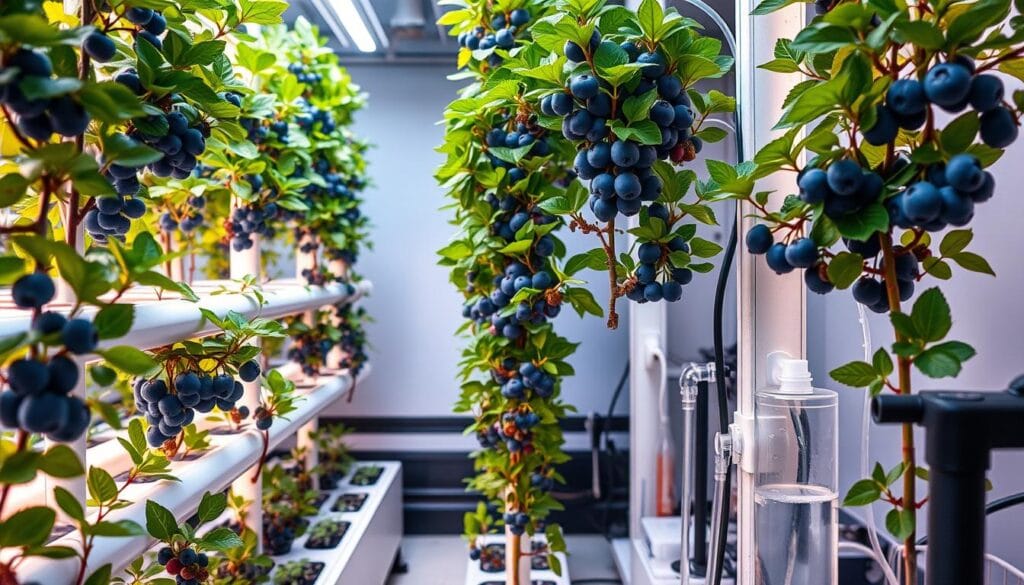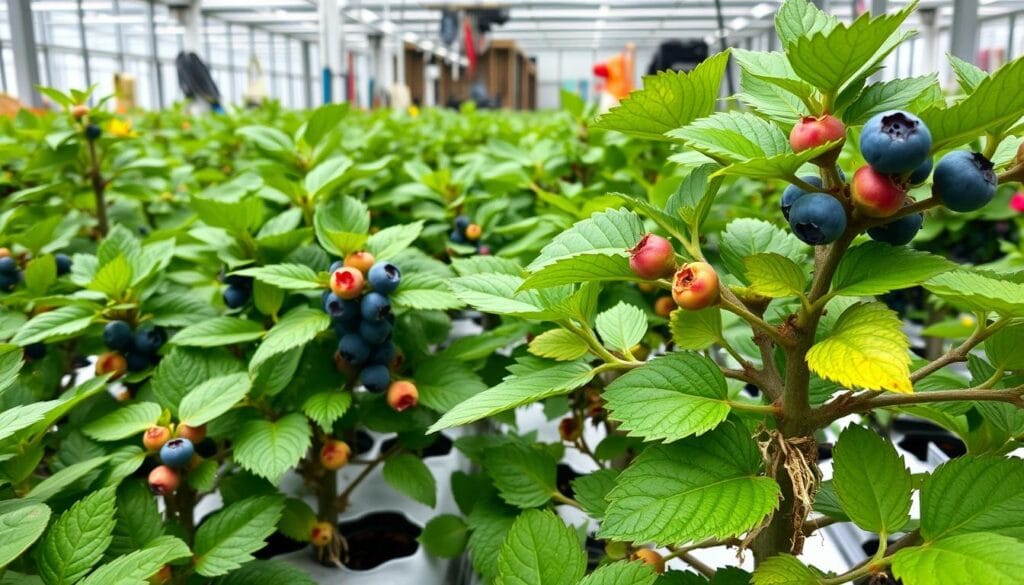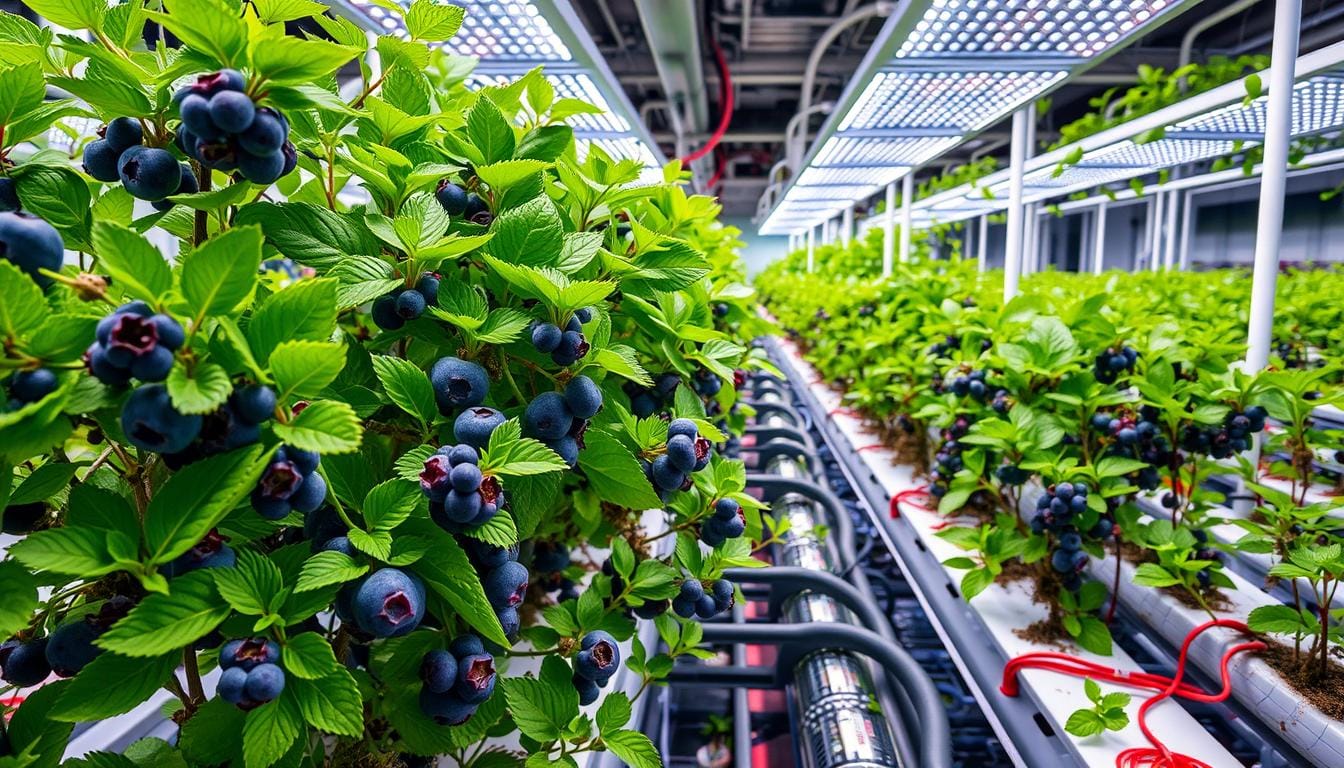Grow blueberries in a hydroponic setup and transform your indoor garden into a fruit haven. With the right techniques, enjoy fresh, juicy blueberries year-round, breaking traditional limits.
Growing blueberries hydroponically is more than a hobby—it’s a new way to grow fruit sustainably. You get to control your plant’s environment, boosting yields and saving water. The hydroponics system offers precision gardening that soil methods can’t match.
Whether you’re an experienced gardener or just starting, learning hydroponic blueberry cultivation opens up new possibilities. You can grow fresh, delicious fruit right at home.
Key Takeaways
- Hydroponic systems provide precise nutrient control for blueberries
- Year-round cultivation is possible with indoor hydroponic setups
- Water efficiency is significantly improved compared to traditional growing
- Consistent environments lead to more predictable fruit production
- Reduced pest and disease risks compared to soil-based growing
Understanding the Basics of Hydroponic Blueberry Cultivation
Indoor blueberry growing has changed the way we produce fruit. It offers new ways to farm blueberries without soil. Hydroponic systems let you grow delicious blueberries in a controlled space, making the most of your area and increasing your harvest.
Types of Hydroponic Systems for Blueberries
Looking into a blueberry hydroponic setup guide, you’ll find several main types:
- Deep Water Culture (DWC)
- Nutrient Film Technique (NFT)
- Drip irrigation systems
- Vertical hydroponic setups
Essential Equipment and Materials
To grow blueberries indoors, you need specific tools:
| Equipment | Purpose |
|---|---|
| LED Grow Lights | Provide an optimal light spectrum |
| pH Meters | Monitor nutrient solution acidity |
| Air Pumps | Ensure proper oxygen circulation |
| Growing Media | Support root development |
Space Requirements and Setup Costs
Planning is key for your soilless blueberry farming journey. Experts suggest giving each plant 2-3 square feet of space. The cost to start can be between $500 to $2,000, based on your system’s design and size.
Agricultural Innovation Research states that hydroponic systems have the potential to boost yields by as much as 30% when compared to traditional gardening methods.
Selecting the Right Blueberry Varieties for Hydroponics
Selecting the appropriate blueberry varieties for hydroponic cultivation is crucial for achieving success.You need to pick ones that do well in hydroponics. They should grow well in controlled environments.
Not all blueberries are good for hydroponics. Some grow better in containers and with controlled nutrients. Here are some top picks:
- Northland: Compact growth, excellent for small spaces
- Patriot: High yield, strong roots
- Chandler: Large berries, consistent yield
When choosing, think about a few things:
- Chilling needs
- Harvest time
- Flavor
- Growth habit
| Variety | Growth Characteristics | Yield |
|---|---|---|
| Northland | Compact, cold-hardy | Medium to High |
| Patriot | Strong root development | High |
| Chandler | Large fruit size | Very High |
As noted by a Hydroponic Growing Expert, “Choosing the right blueberry variety is akin to picking the ideal teammate—compatibility and performance are essential.”
Pro tip: Consider your hydroponic system’s conditions when picking a variety. Climate, light, and nutrient management matter a lot.
Creating the Perfect Growing Environment
To grow blueberries indoors, you need to create the right environment. This environment should be similar to where blueberries grow naturally. Your hydroponic setup guide will help you focus on key factors that affect your plants’ health and how much fruit they produce.
Temperature Control Guidelines
Blueberries don’t like big temperature changes. Keeping the temperature just right is key for your hydroponic setup. The optimal daytime temperature for growth ranges between 15°C and 21°C (60°F to 70°F).
- Daytime ideal temperature: 15-21°C (60-70°F)
- Nighttime ideal temperature: 10-15°C (50-60°F)
- Avoid temperature fluctuations greater than 10°C
Humidity Management
Keeping the right humidity is important. It helps prevent stress and disease in your blueberry plants.
| Humidity Stage | Ideal Percentage | Recommended Action |
|---|---|---|
| Vegetative Growth | 50-60% | Use humidity trays or misters |
| Flowering Stage | 55-65% | Implement gentle air circulation |
| Fruit Development | 50-70% | Monitor with hygrometer |
Air Circulation Requirements
Good air movement is key to preventing disease and making plants stronger. Your hydroponic guide suggests using fans to move air gently.
“Proper air circulation is as important as nutrient management in hydroponic blueberry cultivation.” – Hydroponic Research Institute
- Install fans at the plant canopy level
- Ensure 360-degree air movement
- Avoid direct, strong airflow
- Maintain consistent air exchange
Professional tip: Invest in a small climate control system to automate temperature, humidity, and air circulation for consistent growing conditions.
How to Grow Blueberries in a Hydroponic Setup: Step-by-Step Guide
Learning to grow blueberries in a hydroponic setup needs careful planning and precise steps. You must understand each important part of the blueberry hydroponic setup guide.

Before starting your hydroponic blueberry journey, you need to prepare:
- Choose the right hydroponic system for blueberries
- Pick the best growing medium
- Make nutrient solutions that blueberries need
- Set up the best environment for growth
“The key to successful hydroponic blueberry cultivation is creating a controlled, nutrient-rich environment” – Hydroponic Farming Expert
When growing blueberries hydroponically, remember these key points:
| Component | Specification | Importance |
|---|---|---|
| pH Level | 4.5 – 6.0 | Critical for nutrient absorption |
| Electrical Conductivity | 1.5 – 2.5 mS/cm | Ensures proper nutrient concentration |
| Plant Spacing | 30-60 cm | Allows adequate light and nutrient distribution |
Your hydroponic blueberry system needs constant monitoring. Regular checks of pH levels, nutrient solutions, and plant health are key for success.
- Use LED grow lights for 12-16 hours daily
- Keep temperatures between 60-75°F
- Ensure proper air circulation
- Watch for pests
By following these steps, you’ll create the best environment for growing healthy, productive blueberries in your hydroponic setup.
Mastering pH and Nutrient Solutions for Blueberry Growth
Cultivating blueberries hydroponically requires meticulous management of nutrients and pH levels.Knowing how to balance blueberry hydroponic nutrients and pH levels is key to success.
Your hydroponic blueberry system needs focus on nutrients and pH balance. The right strategy can greatly improve your growing experience and berry quality.
Optimal pH Ranges for Blueberry Growth
Blueberries do best in slightly acidic conditions. Keep your hydroponic system’s pH between 4.5 and 5.5 for best nutrient uptake. This range helps plants grow healthy and strong.
- Ideal pH range: 4.5-5.5
- Regular pH testing recommended
- Use precise pH adjustment solutions
Essential Nutrient Ratios
Blueberry hydroponic nutrients are vital for plant health and fruit production. A balanced mix is essential for growth.
| Nutrient | Function | Recommended Concentration |
|---|---|---|
| Nitrogen (N) | Leaf and stem growth | 50-100 ppm |
| Phosphorus (P) | Root development | 30-50 ppm |
| Potassium (K) | Fruit quality | 100-150 ppm |
Water Quality Requirements
Water quality affects blueberry hydroponic pH levels and nutrient absorption. Use filtered or reverse osmosis water to avoid mineral buildup and ensure the best growing conditions.
“Success in hydroponic blueberry cultivation is 90% preparation and 10% execution.” – Hydroponic Farming Expert
By keeping nutrient solutions and pH levels precise, you’ll create a perfect environment. This will lead to robust, flavorful blueberries that outshine those grown in soil.
Lighting Requirements and Photoperiod Management
Understanding light needs is key to growing blueberries indoors. Blueberry hydroponic grow lights are essential for plant growth and fruiting. Your lighting plan is critical for successful blueberry cultivation.
When picking blueberry hydroponic grow lights, keep these points in mind:
- Full spectrum LED grow lights are best
- Ensure 6-8 hours of direct light each day
- Go for 12-16 hours of light every day
- Light intensity should be 600-900 μmol/m²/s at canopy level
Pro tip: Use digital timers to keep photoperiods consistent and mimic natural day-night cycles.
“Light is the architect of plant growth – design your indoor environment wisely.” – Hydroponic Farming Experts
In winter, extra lighting is needed for constant production. Different blueberry types might need different light levels. Watch how your plants react and adjust your lighting as needed.
Today’s LED tech lets you control light wavelengths. This helps you tailor light for growth and fruiting in your indoor blueberry setup.
Pruning and Training Hydroponic Blueberry Plants
Pruning and training are key to growing hydroponic blueberries. They keep plants healthy and boost fruit production. This is a critical factor for ensuring the success of a hydroponic blueberry system.
Understanding Pruning Fundamentals
Pruning is vital for hydroponic blueberries. It shapes the plant and boosts growth. Your goal is to make the plant’s canopy open and airy. This lets in plenty of light and air.
Timing Your Pruning Schedule
Prune your hydroponic blueberries in late winter. This is when they are dormant. Focus on these main tasks:
- Remove dead or damaged branches
- Cut out crossing or inward-growing limbs
- Thin out dense areas to improve air circulation
- Maintain an open center structure
Training Techniques for Maximum Yield
Training your blueberries in a hydroponic setup is about creating support. This guides growth and boosts productivity.
| Training Method | Benefits | Implementation |
|---|---|---|
| Vertical Trellising | Increases light exposure | Use adjustable wire systems |
| Stake Support | Prevents branch breakage | Install sturdy stakes near plant base |
| Canopy Management | Improves air circulation | Regular pruning and branch positioning |
“Proper pruning is like giving your blueberry plants a strategic haircut that promotes healthier, more productive growth.” – Hydroponic Farming Expert
Prune your plants regularly during the growing season. This keeps them in shape and boosts fruit production in your blueberry hydroponics system.
Common Challenges and Troubleshooting Tips

Growing blueberries in a hydroponic setup can be tricky. It needs careful watching and quick action. Knowing how to fix problems early is key to success.
When starting with blueberries in hydroponics, focus on a few main areas:
- Nutrient Management
- pH Balance
- Pest Control
- Disease Prevention
Nutrient issues can hurt your blueberry hydroponic setup. Watch for these important nutrients:
| Nutrient | Potential Deficiency Signs | Recommended Action |
|---|---|---|
| Potassium | Leaf edge browning | Adjust nutrient solution ratio |
| Iron | Yellowing between leaf veins | Use chelated iron supplements |
| Nitrogen | Overall pale green coloration | Increase nitrogen in nutrient mix |
Keeping the pH between 4.5 and 6.0 is vital for nutrient uptake in your hydroponic blueberry system. Get a good pH meter to keep levels right.
“The key to successful hydroponic blueberry cultivation is prevention, not cure.” – Hydroponic Farming Expert
Controlling pests needs a mix of methods. Here’s what to do:
- Use sticky traps to monitor insect populations
- Introduce beneficial insects like ladybugs
- Maintain proper air circulation
- Regularly inspect plants for early signs of infestation
Always have a plan to watch your plants closely. Look for stress, color changes, or odd growth every day. Identifying problems early can prevent them from escalating.
Harvesting and Post-Harvest Care
Harvesting your hydroponic blueberries is a thrilling moment. Your hard work in growing them indoors will pay off. You’ll get delicious, nutrient-rich berries if you know how to harvest and store them right.
Determining Ripeness
Knowing when to pick your hydroponic blueberries is key. Look for these signs:
- Deep blue color across the entire berry surface
- Slight softness when gently squeezed
- Easy separation from the plant with minimal effort
Best Storage Practices
Keeping your blueberries fresh and tasty is important. Here are some tips for storing your indoor blueberry harvest:
| Storage Method | Temperature | Humidity | Expected Shelf Life |
|---|---|---|---|
| Refrigeration | 32-34°F (0-1°C) | 90-95% | Up to 2 weeks |
| Freezing | 0°F (-18°C) | N/A | 6-12 months |
Pro tip for hydroponic blueberry cultivation: Pick berries every 3-5 days when they’re ripe. This keeps them fresh and prevents them from getting too ripe.
“Gentle handling is the key to preserving the quality of your homegrown hydroponic blueberries.” – Hydroponic Growing Expert
When freezing, spread berries on a baking sheet first. Then put them in airtight containers. This stops them from sticking together and keeps them fresh for a long time.
Conclusion
Growing blueberries in a hydroponic setup is a new way to farm fruits. This guide has shown you how to do it well. With the right care, your blueberry plants can grow better than they would in soil.
Hydroponic blueberry growing saves water and lets you control the growing conditions. Keeping the EC values right and spacing plants correctly can make your crop better. You can also manage the pH levels to help your plants grow well.
Success in growing hydroponic blueberries comes from learning and watching your plants closely. By using the tips from this guide, you can make a system that grows great fruits with less harm to the environment. Every hydroponic setup is different, so being ready to change and improve is important for a good harvest.
As you keep growing hydroponic blueberries, you’ll see it’s more than just growing fruits. It’s a new way to farm that uses resources wisely and is kind to the environment. Learning and using these methods will change how you see farming today.

